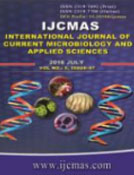


 National Academy of Agricultural Sciences (NAAS)
National Academy of Agricultural Sciences (NAAS)

|
PRINT ISSN : 2319-7692
Online ISSN : 2319-7706 Issues : 12 per year Publisher : Excellent Publishers Email : editorijcmas@gmail.com / submit@ijcmas.com Editor-in-chief: Dr.M.Prakash Index Copernicus ICV 2018: 95.39 NAAS RATING 2020: 5.38 |
Polyhydroxyalkanoates (PHAs) are accumulated in bacteria as an energy reserve and have attracted great scientific interest as a biodegradable, biocompatible alternative to conventional plastics. The study is focused on polyhydroxybutyrate (PHB) accumulation by an environmental bacterial isolate Bacillus megaterium PHB29 using starch as carbon feedstock. PHB accumulation in the isolate was visualized by staining techniques using Sudan Black B and Nile Red dyes. The biomass production as well as PHA accumulation in PHB29 was tested with starch as carbon source at different temperatures and found yielding 3.07 g/L cell dry mass with 73.46% (w/w) PHA accumulation at an optimum temperature 34oC. The extracted polymer was subjected to 1H NMR analysis and the spectrum showed signals for a methine group (-CH-), a methylene group (-CH2-) and a methyl group (-CH3) proving the polymer as poly-3-hydroxybutyrate (PHB). The ratio of starch to PHB conversion of this isolate was found to be better than other reported strains of Bacillus megaterium as well as other species among the genus Bacillus.
 |
 |
 |
 |
 |